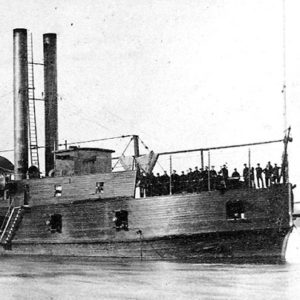calsfoundation@cals.org
USS Conestoga
The first of two vessels named Conestoga, this converted sidewheel steamer saw extensive service with the Union’s Western Gunboat Fleet during the Civil War, including operations on the Arkansas, White, Black, Tensas, and Ouachita rivers during the ongoing battle for control of significant interior rivers in the Trans-Mississippi Department.
Originally built in 1859 in Brownsville, Pennsylvania, as a sidewheel steamer displacing between 297 and 572 tons, the Conestoga was purchased by the U.S. Army Quartermaster on June 3, 1861, and converted into a wood-clad gunboat for service with the Western Gunboat Fleet on the Mississippi River and various tributaries. Although under the army’s operational control, the vessel was commanded by Lieutenant S. Ledyard Phelps of the U.S. Navy. Initial duties included several months of routine patrol on the Mississippi River and minor contact with shore-based Confederate forces. On February 6, 1862, the Conestoga participated in the capture of Fort Henry on the Tennessee River as part of Rear Admiral Andrew H. Foote’s gunboat fleet. Immediately thereafter, the Conestoga joined the USS Lexington and the USS Tyler in an operation at Florence, Alabama, where they captured an unfinished Confederate gunboat and two steamers, also destroying a cache of war materials. Afterward, the Conestoga rejoined Foote’s fleet and served in the capture of Fort Donelson on the Cumberland River.
Between June 13 and July 9, 1862, the Conestoga participated in naval operations on the White River, including action against St. Charles (Arkansas County). Transferred to the U.S. Navy on October 1, 1862, the Conestoga performed patrol and convoy service on the Arkansas, White, and Mississippi rivers through the summer of 1863 and bombarded Confederate shore positions. The Conestoga also served in operations against Vicksburg, Mississippi, between May 19 and July 4, 1863. After the surrender of Vicksburg, the Conestoga served with the navy’s expedition up the Black, Tensas, and Ouachita rivers between July 12 and 20, 1863, and in operations on the Black and Ouachita rivers between February 29 and March 5, 1864.
On the morning of March 8, 1864, while returning from New Orleans, Louisiana, with a shipment of ammunition for the upcoming Red River Campaign and under the command of Lieutenant Commander Thomas O. Selfridge, the Conestoga collided with General Sterling Price, a captured former Confederate ram then serving with the Western Gunboat Fleet, and sank at Bondurant Point near Bruinsburg, Mississippi, with a loss of two men drowned.
For additional information:
Dictionary of American Naval Fighting Ships. http://www.history.navy.mil/research/histories/ship-histories/danfs.html (accessed April 20, 2017).
Smith, Myron J., Jr. The Timberclads in the Civil War: The Lexington, Conestoga and Tyler on the Western Waters. Jefferson, NC: McFarland and Company, 2008.
The War of the Rebellion: A Compilation of the Official Records of the Union and Confederate Armies. Series 1, Vol. 4. Washington DC: Government Printing Office, 1882.
The War of the Rebellion: A Compilation of the Official Records of the Union and Confederate Armies. Series 1, Vol. 24, Part 1. Washington DC: Government Printing Office, 1889.
The War of the Rebellion: A Compilation of the Official Records of the Union and Confederate Armies. Series 1, Vol. 24, Part 3. Washington DC: Government Printing Office, 1889.
Robert Patrick Bender
Eastern New Mexico University–Roswell
 Civil War through Reconstruction, 1861 through 1874
Civil War through Reconstruction, 1861 through 1874 Military
Military ACWSC Logo
ACWSC Logo  USS Conestoga
USS Conestoga 




Comments
No comments on this entry yet.